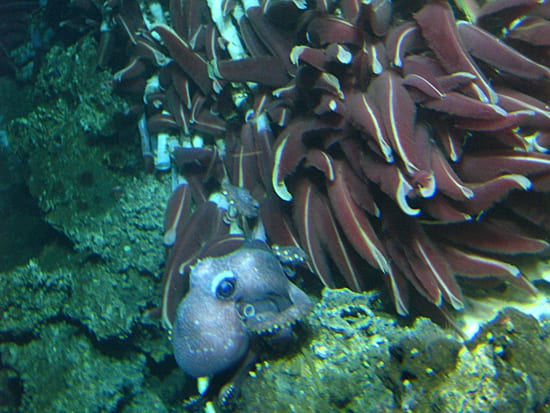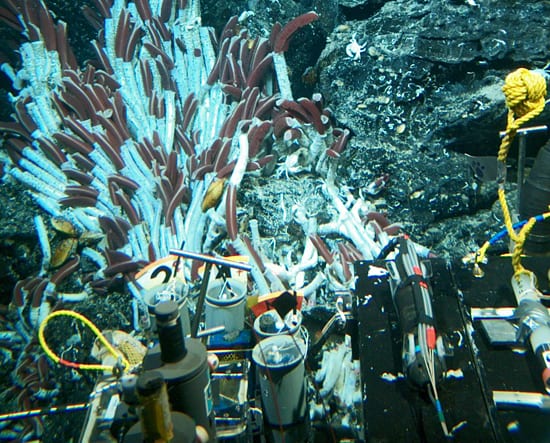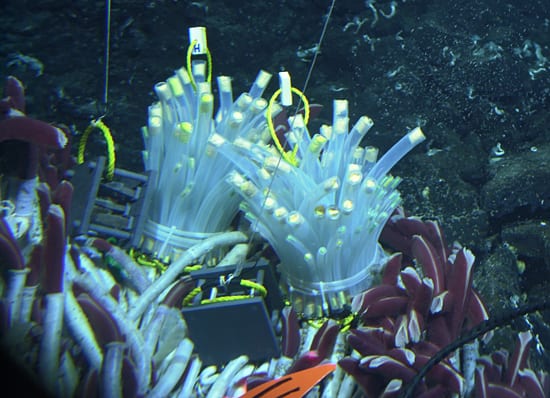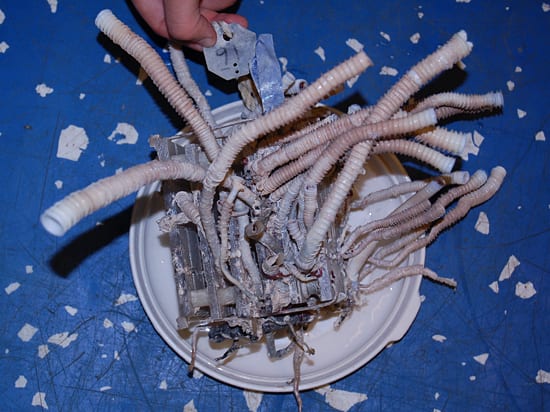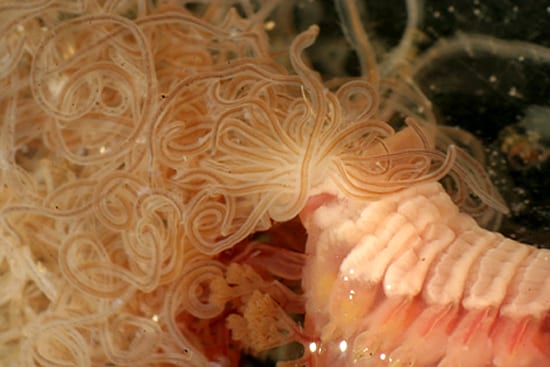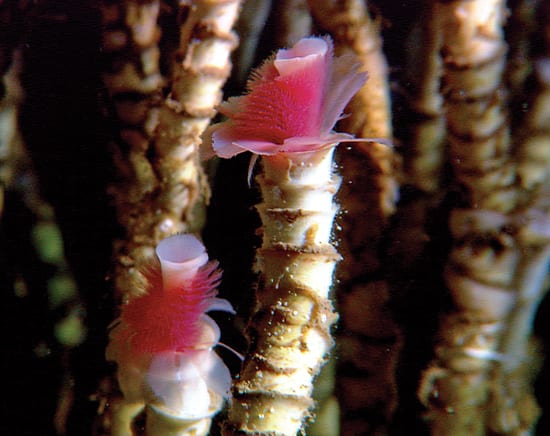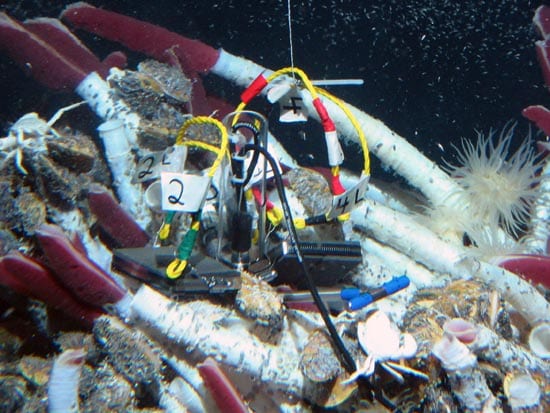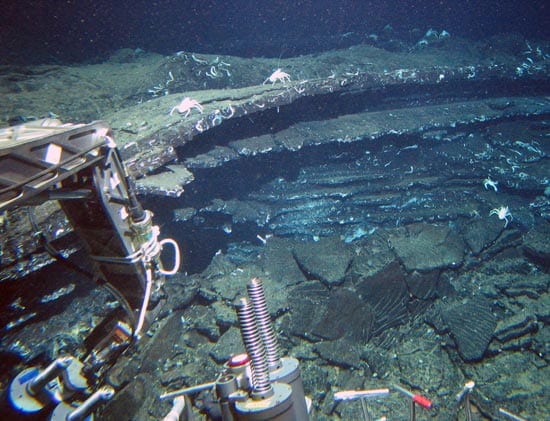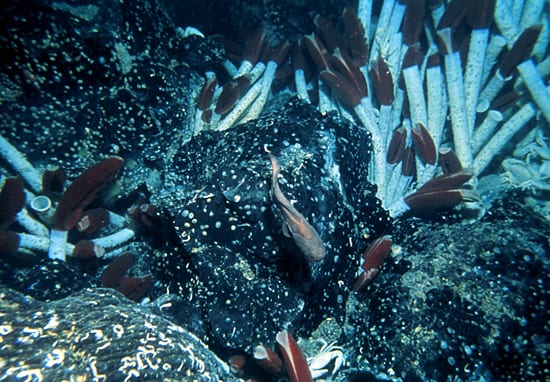- During a dive to the deep-sea hydrothermal vents at Guaymas Basin (Gulf of California, Mexico), an octopus eyes the submersible Alvin. The dive was conducted as part of an R/V Atlantis research cruise funded by the National Science Foundation to investigate the ecology and geochemistry of microorganisms that 'eat' natural gas. (Photo by Stefan Sievert, Woods Hole Oceanographic Institution)
- This picture of tubeworms was taken in the East Pacific Rise at a depth of 8,200 feet (2,500 meters) by the Human Occupied Vehicle Alvin. Since the discovery of hydrothermal vents in 1977, scientists have been learning how life can exist without the energy of the sun but rather on the chemical energy at the vents. The tubeworms’ feather-like red plumes act as gills, absorbing oxygen from seawater and hydrogen sulfide from vent fluids and transporting the chemicals to bacteria that lives in their gut. The bacteria inside the tubeworms oxidize hydrogen sulfide to create energy. The tubeworms get a steady supply of organic carbon and can grow prolifically, tacking on roughly 31 inches (80 centimeters) of white tube to their bodies every year and can reach length of 6 feet. (Photo courtesy of Woods Hole Oceanographic Institution)
- To test whether complex physical structure could maintain the species diversity hydrothermal vent communities in areas of chemosynthetic primary production, Breea Govenar, a Postdoctoral Investigator in the Biology Department, deployed bundles of flexible PVC hose in the size frequency and density of natural aggregations of the giant tubeworm Riftia pachyptila along a gradient in productivity at a low-temperature hydrothermal vent on the East Pacific Rise. After one year, there were the same number of species in natural and artificial aggregations, exposed to diffuse hydrothermal fluids. (Photo courtesy of Woods Hole Oceanographic Institution)
- A cluster of Tevnia jerichonana tubeworms sprout from a "sandwich"—an artificial colonization surface made of the non-toxic plastic lexan. The sandwich was recovered from the seafloor after spending 11 months in a hydrothermal vent habitat along the East Pacific Rise by biologists. The experiment was designed to examine the influence of larval supply on the colonization of new vents following a seafloor eruption in 2005-2006. (Photo by Lauren Mullineaux, Woods Hole Oceanographic Institution)
- Magnified under a microscope, the tentacles of a terebellid —a marine polychaete worm, also called the "spaghetti worm"—look like an impossible tangle of pink yarn or vermicelli. Those sticky tentacles are used for feeding. Brought up by the submersible Alvin from 2,450 meters (8,100 feet) depth, the terebellid was found on an expedition co-led by biologist Tim Shank to the "Rosebud" hydrothermal vent site near the Galapagos Islands. The seafloor in the area had been covered by fresh lava and was being re-colonized by strange deep-sea animals. (Photo by Stace Beaulieu, Woods Hole Oceanographic Institution)
- Methane seeping from the seafloor sustains microbes that serve as the base of the food chain for communities of animals, like these tubeworms, which thrive in the sunless depths. Far more natural gas is sequestered on the seafloor—or leaking from it—than can be drilled from all the existing wells on Earth. (High-definition images copyright Woods Hole Oceanographic Institution and the BBC Natural History Unit, courtesy of the WHOI Advanced Imaging and Visualization Laboratory and Johnson-Sea-Link submersible, Harbor Branch Oceanographic Institution)
- At the experiment site at the Tica Vent on the East Pacific Rise, basalt panels were placed in the center of a tubeworm colony to see if larvae would settle there. (Photo by Stace Beaulieu, Woods Hole Oceanographic Institution)
- Crabs thrive in a new vent site on the Galapagos Rift found in 2005. Its concave shape and lineage to previously found sites called Rose Garden and Rosebud--suggested the name "Rose Bowl." (Photo by Adam Soule, Woods Hole Oceanographic Institution)
- Before the discovery of hydrothermal vents in 1977, no one expected to see abundant life in the deep sea, where darkness and cold temperatures reign. But chemical-rich fluids gushing from hydrothermal vents provide energy for lush communities of organisms—like red-and-white tubeworms that have no digestive system, surviving on internal bacteria that use chemicals rather than sunlight for energy. Scientists are concerned that deep seafloor mining near vent sites could damage these communities. (Photo courtesy of Woods Hole Oceanographic Institution Archives)
SEARCH RELATED TOPICS: Life at Vents & Seeps
Image and Visual Licensing
WHOI copyright digital assets (stills and video) contained on this website can be licensed for non-commercial use upon request and approval. Please contact WHOI Digital Assets at images@whoi.edu or (508) 289-2647.
